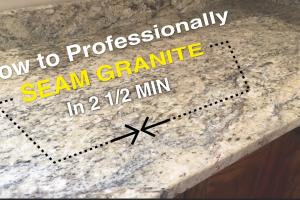Mastering the Art of Seamless Granite Countertops: A Comprehensive Guide

-
Quick Links:
- Introduction
- Understanding Granite and Its Characteristics
- Why Seam Granite Countertops?
- Different Methods of Seaming Granite Countertops
- Essential Tools and Materials for Seaming
- Step-by-Step Guide to Seam Granite Countertops
- Case Studies: Successful Seaming Projects
- Expert Insights and Tips
- Maintaining Seamless Granite Countertops
- FAQs
Introduction
Granite countertops are a popular choice for kitchens and bathrooms, thanks to their durability and aesthetic appeal. However, when working with large slabs of granite, seaming becomes a crucial aspect of installation. This guide will explore how to seam together granite countertops effectively, providing you with the knowledge and skills to achieve a seamless look.
Understanding Granite and Its Characteristics
Granite is an igneous rock composed mainly of quartz, feldspar, and mica. It's known for its strength, resistance to heat, and ease of maintenance. Each slab of granite is unique, showcasing different colors and patterns which can affect how seams appear.
- Durability: Granite can withstand heavy use and is resistant to scratches and heat.
- Variety: Available in numerous colors and patterns, allowing for personalized designs.
- Maintenance: Requires regular sealing to prevent stains and maintain its luster.
Why Seam Granite Countertops?
Seaming granite countertops is necessary for various reasons:
- Large Surface Areas: Many countertops require multiple slabs to cover the entire surface.
- Design Flexibility: Seams can be strategically placed to enhance the design.
- Cost-Effectiveness: Utilizing smaller slabs can save money while still achieving the desired look.
Different Methods of Seaming Granite Countertops
There are several methods to seam granite, each with its own advantages:
- Epoxy Seaming: This is the most common method using a color-matched epoxy resin to bond slabs.
- Mechanical Seaming: This technique involves using mechanical fasteners to hold the slabs together.
- Invisible Seaming: A more advanced method that minimizes the visibility of seams through careful cutting and treatment.
Essential Tools and Materials for Seaming
To successfully seam granite countertops, you will need the following tools and materials:
- Granite seaming kit
- Diamond blade saw
- Epoxy resin
- Seam clamps
- Polishing pads
- Masking tape
- Protective gear (gloves, goggles)
Step-by-Step Guide to Seam Granite Countertops
Step 1: Measure and Cut the Granite
Accurate measurements are crucial. Use a diamond blade saw to cut the granite slabs, ensuring the edges are straight and smooth.
Step 2: Prepare the Seams
Clean the seam edges with a damp cloth to remove dust and debris. Place the slabs together and check for fit.
Step 3: Apply Epoxy Resin
Mix the epoxy resin according to the manufacturer's instructions and apply it to the edges of the seams.
Step 4: Clamp the Slabs Together
Use seam clamps to hold the slabs securely in place while the epoxy cures, typically for 24 hours.
Step 5: Polish the Seam
Once cured, use polishing pads to smooth out the seam, making it less visible and creating a polished finish.
Case Studies: Successful Seaming Projects
Here are a few examples of successful granite seaming projects:
Case Study 1: Kitchen Renovation
In a recent kitchen renovation, a homeowner used epoxy seaming to join two large granite slabs, creating a seamless look that enhanced the overall design.
Case Study 2: Bathroom Countertop
A small bathroom remodel utilized mechanical seaming to join smaller granite pieces, achieving both functionality and style.
Expert Insights and Tips
Experts recommend the following best practices:
- Always wear protective gear when working with granite.
- Use high-quality epoxy for better durability and color match.
- Practice proper techniques for cutting and polishing to avoid damaging the granite.
Maintaining Seamless Granite Countertops
To keep your granite countertops looking their best, follow these maintenance tips:
- Seal the granite regularly to prevent stains.
- Use gentle cleansers and avoid acidic or abrasive materials.
- Wipe up spills immediately to prevent staining.
FAQs
1. Can I seam granite countertops myself?
Yes, with the right tools and materials, DIY seaming is possible, although professional help is recommended for best results.
2. What is the best adhesive for granite seams?
Epoxy resin is the most commonly used adhesive due to its strong bonding properties and color-matching capabilities.
3. How long does it take for epoxy to cure?
Epoxy typically takes 24 hours to cure fully, although it may be safe to use after a few hours.
4. How do I hide a seam in granite?
Using color-matched epoxy and polishing the seam properly can help to minimize its visibility.
5. Is granite seaming expensive?
Costs can vary depending on the method and materials used, but seaming is generally more affordable than replacing whole slabs.
6. How can I clean granite seams?
Use a mild soap and warm water to clean seams. Avoid harsh chemicals that could damage the epoxy.
7. Can seams become damaged over time?
Yes, seams can become damaged due to heavy use, but regular maintenance can minimize this risk.
8. Do seams affect the durability of granite countertops?
Properly done seams do not affect the overall durability of granite countertops when installed correctly.
9. What should I do if my granite seam cracks?
Consult a professional to assess the damage and perform necessary repairs.
10. Can I change the color of my granite seams?
While you cannot change the color of existing epoxy, you can remove and reapply a different color if needed.